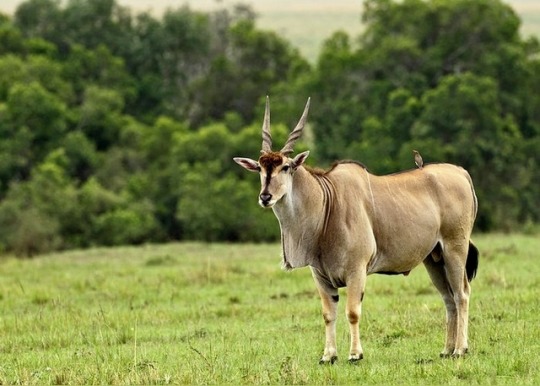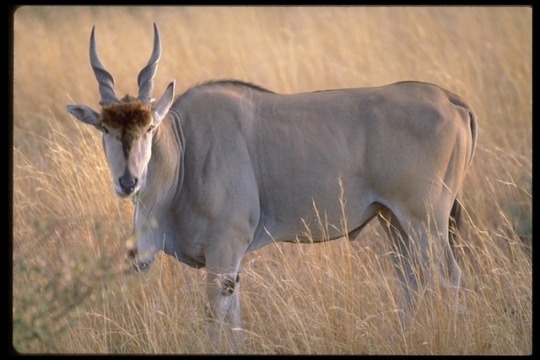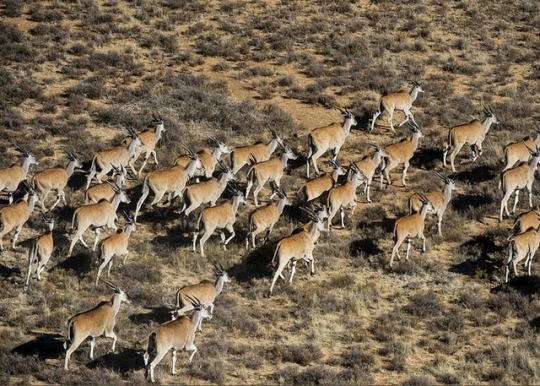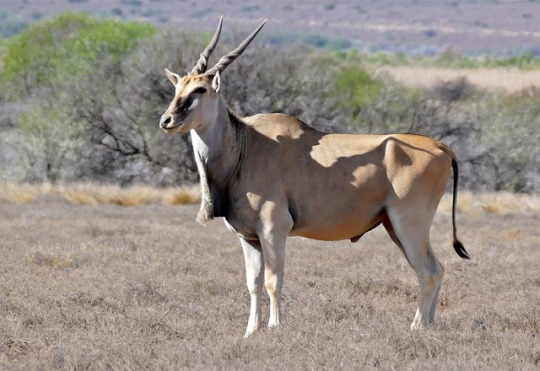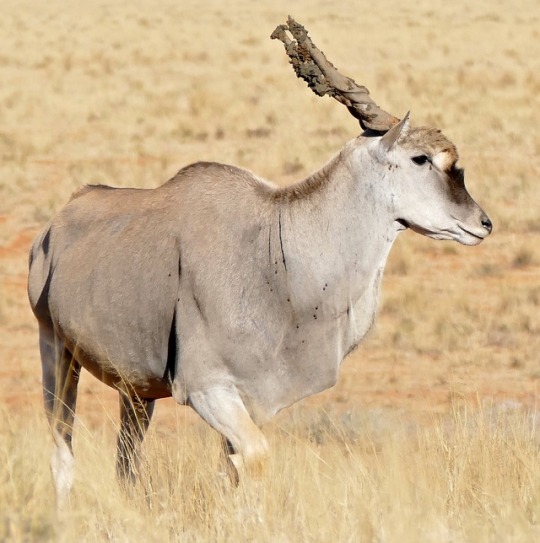#taurotragus oryx
Text

A common eland (Taurotragus oryx) in Camdeboo National Park, South Africa
by Bernard Dupont
#common eland#antelopes#taurotragus oryx#taurotragus#bovidae#artiodactyla#chordata#wildlife: south africa#wildlife: africa
786 notes
·
View notes
Text

緑色に映える動物だ
@豊橋動植物公園
I think elands are most beautiful animals that stand out in green surroundings.
@Toyohashi Zoo & Botanical Park
24 notes
·
View notes
Text
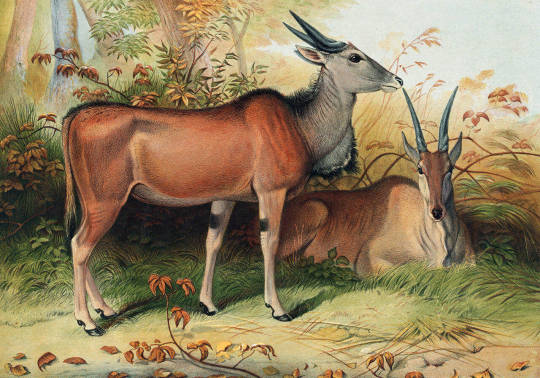
Eland (Taurotragus oryx) | Joseph Wolf (1820-1899)
11 notes
·
View notes
Text
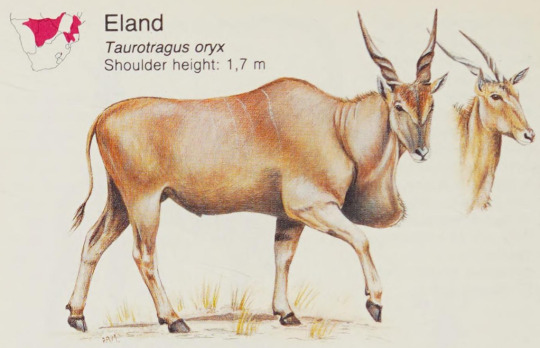
Taurotragus oryx. Struik Pocket Guides for South Africa: Mammals. Written by John Skinner. Illustrated by Penny Meakin. 1988.
Internet Archive
83 notes
·
View notes
Text
Common Eland Antilope: What You Need to Know
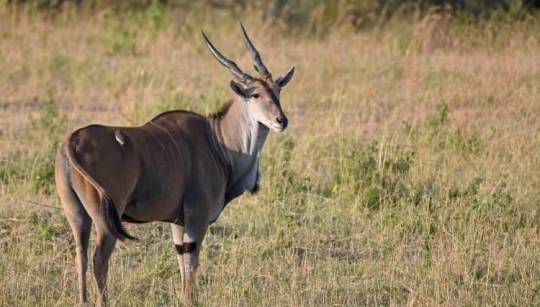
f you've ever wanted to know all there is to know about Common Eland Antilope, then this guide is for you.
What is Common Eland Antilope?
The Common Eland Antelope, also known as the Southern or African Eland, is a species of large antelope found in savannah and grassland habitats throughout sub-Saharan Africa. They are the second-largest antelope species following the Giant Eland.
Common Elands have a distinctive tan or chestnut coat with white stripes on their sides and a dewlap hanging from their necks. Both males and females grow long, spiral horns that can reach up to four feet in length. They are herbivores, feeding mainly on leaves, shoots, and grasses.
These antelopes live in herds of up to 500 individuals and are known for their impressive jumping abilities; they can leap over eight-foot fences effortlessly.
What is Common Eland Antilope Size?

What is Common Eland Antilope Size?
The Common Eland (Taurotragus oryx) is a large antelope species, and its size can vary depending on factors such as age, sex, and geographic location. Here are some general size measurements for Common Elands:
-
Shoulder Height: Common Elands typically have a shoulder height ranging from 1.6 to 1.9 meters (5.2 to 6.2 feet). Adult males tend to be slightly taller than females.
-
Weight: The weight of Common Elands can vary significantly. Adult males can weigh between 400 to 1,000 kilograms (880 to 2,200 pounds), while adult females generally weigh between 300 to 600 kilograms (660 to 1,320 pounds).
-
Horn Length: Both male and female Common Elands have long, spiral-shaped horns. The length of the horns can reach up to 65 centimeters (26 inches) in mature individuals. The horns are slightly longer and thicker in males compared to females.
It's important to note that these measurements are approximate and can vary among individuals and populations. Common Elands are known for their robust build, making them one of the largest antelope species in the world.
Where Are Common Eland Antilope Found?
Common Eland (Taurotragus oryx) is native to various regions of Eastern and Southern Africa. They can be found in several countries across the continent. Here are some of the countries where Common Eland populations are present:
-
South Africa: Common Elands are found in different parts of South Africa, including national parks and game reserves such as Kruger National Park, Kgalagadi Transfrontier Park, and Hluhluwe-Imfolozi Park.
-
Namibia: They can be found in various regions of Namibia, including Etosha National Park, Waterberg Plateau Park, and the Caprivi Strip.
-
Botswana: Common Elands inhabit areas of Botswana, particularly in the northern parts of the country, including Chobe National Park and Okavango Delta.
-
Zimbabwe: They are found in different regions of Zimbabwe, including Hwange National Park, Matobo National Park, and Gonarezhou National Park.
-
Tanzania: Common Elands can be found in various areas of Tanzania, including Serengeti National Park, Ngorongoro Conservation Area, and Selous Game Reserve.
-
Kenya: They are present in parts of Kenya, such as Maasai Mara National Reserve, Amboseli National Park, and Tsavo National Park.
-
Zambia: Common Elands can be found in some regions of Zambia, including South Luangwa National Park and Kafue National Park.
These are just a few examples, and Common Elands can also be found in other neighboring countries in Eastern and Southern Africa. They typically inhabit open grasslands, savannas, woodlands, and mountainous regions, adapting to a range of environments with access to suitable vegetation and water sources.
What is the Common Eland Antilope habitat?
The Common Eland (Taurotragus oryx) inhabits a variety of habitats across its range in Eastern and Southern Africa. Here are some common habitats where Common Elands are found:
-
Grasslands: They are well adapted to open grasslands and can be found in both short grasslands and tall grass savannas. These habitats provide them with ample grazing opportunities.
-
Woodlands: Common Elands can also be found in woodland areas, including miombo woodlands, acacia woodlands, and mixed deciduous woodlands. They are capable of utilizing browse vegetation in addition to grasses.
-
Savannas: They are often found in savanna ecosystems, which consist of a mix of grasses and scattered trees. Savannas provide a balance of grazing and browsing resources.
-
Mountains: Common Elands can inhabit mountainous regions, including the foothills and slopes of mountains. They are known to occur in areas with varying elevations.
-
Riparian Zones: In some areas, Common Elands can be found near rivers, streams, and other water bodies. These riparian zones provide them with access to water and lush vegetation.
It's important to note that Common Elands are adaptable and can occupy a range of habitats, as long as there is a sufficient supply of food, water, and suitable cover. They can adjust their feeding habits based on the available vegetation and can cope with seasonal fluctuations in rainfall and temperature.
The habitat preferences of Common Elands may vary slightly across their range, but they generally inhabit areas with a mix of grasses, browse, and water sources, allowing them to meet their dietary and hydration needs.
What is The Physical Description Of a Common Eland Antilope?
The Common Eland (Taurotragus oryx) has a distinct physical appearance that sets it apart from other antelope species. Here is a description of its physical features:
-
Size: Common Elands are among the largest antelope species. They have a shoulder height ranging from 1.6 to 1.9 meters (5.2 to 6.2 feet). Adult males are generally slightly taller and heavier than females.
-
Body Shape: Elands have a robust and muscular build. They have thick necks and deep, barrel-shaped chests. Their body is supported by sturdy legs.
-
Coat: The coat of a Common Eland is light brown to grayish, which provides effective camouflage in their natural habitats. The coat is generally smooth and short-haired.
-
White Stripes: The sides of the Common Eland are marked by distinctive vertical white stripes. These stripes contrast against the overall coloration of their coat.
-
Dewlap: Both male and female Elands possess a pendulous flap of skin called a dewlap, which hangs from the throat region. The dewlap is more prominent in males and serves as a visual display during courtship and dominance interactions.
-
Horns: Both sexes of Common Elands have long, spiral-shaped horns. The horns are ridged and can reach lengths of up to 65 centimeters (26 inches) in mature individuals. The horns are slightly longer and thicker in males than in females.
-
Facial Features: They have a broad and slightly elongated face. Their eyes are large and positioned laterally, providing them with a wide field of vision.
These physical characteristics contribute to the impressive stature and appearance of the Common Eland, making it an easily recognizable and iconic species in the African savannas and grasslands.
Common Eland Antilope Reproduction -Breeding
The Common Eland (Taurotragus oryx) follows a pattern of breeding and reproduction that includes certain distinctive features. Here's an overview of their reproductive behavior:
-
Breeding Season: Common Elands do not have a specific breeding season. Instead, mating can occur throughout the year. However, there may be peak periods of mating activity within certain populations.
-
Social Structure: Common Elands exhibit a polygynous mating system, where a dominant male mates with multiple females. During the breeding season, dominant males establish territories and actively defend themselves against rival males.
-
Courtship and Mating: When a male is ready to mate, he engages in courtship behaviors to attract females. These behaviors may include parallel walks, displays of head and neck postures, and vocalizations such as grunts and clicks. If a female is receptive, she will allow the male to mount and mate with her.
-
Gestation and Birth: The gestation period for Common Elands is approximately 8 to 9 months. After the gestation period, a single calf, rarely twins, is born. The female typically seeks out a secluded area for giving birth. The calf is born precocial, which means it is relatively developed and able to stand and walk shortly after birth.
-
Parental Care: Female Common Elands provide most of the parental care for their calves. The calf remains close to its mother, who nurses and protects it. The calf starts to eat solid food after a few weeks but continues to nurse for several months. The bond between the mother and calf is strong.
-
Sexual Maturity: Sexual maturity is reached at different ages depending on gender. Females usually reach sexual maturity around 2 to 3 years of age, while males may not reach maturity until they are 4 to 5 years old.
-
Longevity: Common Elands have a relatively long lifespan, with individuals in the wild living up to 15 to 20 years, and occasionally longer in captivity.
It's worth noting that the exact details of Common Eland breeding behavior can vary slightly depending on factors such as population density, habitat conditions, and social dynamics within a specific area.
How Long Does A Common Eland Antilope Live?
Common Elands (Taurotragus oryx) have a relatively long lifespan compared to many other antelope species. In the wild, the average lifespan of Common Elands is around 15 to 20 years. However, some individuals have been known to live longer, with maximum recorded lifespans of up to 25 years or more.
It's important to note that the lifespan of Common Elands can be influenced by various factors, including predation, disease, habitat conditions, availability of resources, and human activities such as hunting and habitat destruction. In protected areas with lower levels of predation and human disturbance, Common Elands may have a higher chance of reaching their maximum lifespan.
In captivity, where they are provided with proper care, nutrition, and veterinary attention, Common Elands can live even longer. In zoos and wildlife reserves, it is not uncommon for Common Elands to reach ages 20 to 25 years or more.
It's worth mentioning that individual variation in lifespan can occur, and factors such as genetics, health, and environmental conditions can also influence the longevity of an individual Common Eland.
Common Eland Antilope Communication And Perception
Common Elands (Taurotragus oryx) employ various forms of communication and possess keen sensory perception to interact with their environment and herd members. Here are some aspects of their communication and perception:
-
Vocalizations: Elands produce a range of vocalizations for communication, including grunts, clicks, and snorts. These vocalizations are used to convey messages to other individuals in their herd, alerting them to potential threats or indicating their presence.
-
Visual Signals: Common Elands use visual cues to communicate with one another. Dominant males may engage in visual displays of head and neck postures to assert their dominance or attract mates. They can also use their large, laterally positioned eyes to monitor their surroundings and detect potential predators.
-
Body Language: Elands communicate through body language, employing various postures and movements. For example, when threatened, they may stand tall and upright, displaying their size to intimidate predators. They can also lower their heads and position their horns defensively during aggressive encounters with other individuals.
-
Scent Marking: Elands have specialized glands on their legs that secrete a strong-smelling substance. By rubbing their legs against trees or vegetation, they leave scent marks as a means of territorial marking and communication with other herd members.
-
Infrasound Communication: Elands are known to produce low-frequency sounds below the range of human hearing, called infrasounds. These infrasounds can travel long distances and are believed to be used for long-range communication between individuals or herds.
-
Sensory Perception: Common Elands have well-developed senses to perceive their environment. Their large, laterally positioned eyes provide them with a wide field of vision, allowing them to detect movement and potential threats from different angles. They also have keen hearing and a well-developed sense of smell, which helps them detect predators and communicate with other individuals.
These communication and sensory abilities play a vital role in maintaining social cohesion, identifying threats, and establishing dominance within the herd. By employing a combination of vocalizations, visual signals, body language, and scent marking, Common Elands can effectively communicate with each other in their natural habitats.
What Does Common Eland Antilope Eat?
Common Elands (Taurotragus oryx) are herbivores and primarily feed on vegetation. Their diet consists mainly of grasses, but they are also capable of browsing on leaves, shoots, and fruits. Here are some key points about their feeding habits:
-
Grasses: Grass forms the bulk of the Common Eland's diet. They consume a variety of grass species, including both short and tall grasses found in their habitats. Elands are adapted to grazing and have specialized digestive systems to process fibrous plant material.
-
Browse: In addition to grasses, Common Elands also feed on browse vegetation. They browse on leaves, shoots, twigs, and branches of shrubs and trees. This provides them with additional nutrients and variety in their diet.
-
Adaptability: Common Elands are highly adaptable feeders and can adjust their diet based on the availability of vegetation in their habitat. They are known to switch between grazing and browsing depending on the season and local conditions.
-
Water Dependency: While they can obtain a significant amount of moisture from the vegetation they consume, Common Elands also have a dependency on water sources. They need access to drinking water regularly to meet their hydration needs.
-
Selective Feeding: Elands can selectively feed on certain plant parts, choosing the most nutritious parts while avoiding thorny or unpalatable vegetation. This selectivity allows them to maximize their intake of essential nutrients.
-
Coping with Limited Resources: Common Elands are well-adapted to habitats with seasonal fluctuations in rainfall and vegetation availability. They can tolerate lower-quality forage during dry periods and make efficient use of the resources in their environment.
Overall, the diet of Common Elands is primarily composed of grasses, supplemented with browse vegetation. Their ability to utilize a variety of plant materials and adapt to changing conditions contributes to their success as grazers and browsers in African grasslands, savannas, and woodlands.
What is Common Eland Antilope Role İn The Ecosystem?
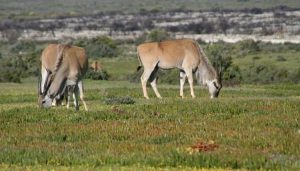
What is Common Eland Antilope Role İn The Ecosystem?
The Common Eland (Taurotragus oryx) plays several important roles in the ecosystems where it resides. Here are some of the key ecological contributions of the Common Eland:
-
Grazing and Browsing: As a herbivore, the Common Eland helps shape vegetation dynamics in its habitat. By grazing on grasses and browsing on leaves and shoots, they influence plant growth, nutrient cycling, and plant community composition. Their feeding behavior can impact vegetation structure and create a mosaic of different plant heights and densities.
-
Seed Dispersal: Common Elands contribute to seed dispersal by consuming fruits and seeds from various plants. As they move across the landscape and defecate, they disperse seeds to different areas. This aids in the dispersal and colonization of plant species, contributing to plant diversity and regeneration in the ecosystem.
-
Nutrient Cycling: Elands help facilitate nutrient cycling in their ecosystems. Through their grazing and browsing activities, they contribute to nutrient transfer from vegetation to the soil through their droppings. The nutrients contained in their feces enrich the soil, promoting plant growth and nutrient availability for other organisms.
-
Prey for Predators: Common Elands serve as an important prey species for large predators in their ecosystems. Lions, hyenas, leopards, and African wild dogs are among the predators that hunt Elands. Their presence in the ecosystem supports predator populations, helping to maintain the balance of predator-prey interactions.
-
Habitat Modification: Elands can impact the physical structure of their habitat through their feeding and movement patterns. Their grazing and browsing behaviors can influence vegetation density, which in turn affects the availability of food and cover for other herbivores, small mammals, and birds.
-
Cultural and Economic Importance: Common Elands have cultural and economic significance for local communities. They are valued for their meat, hides, and horns, which are utilized for food, traditional ceremonies, and crafts. Sustainable hunting and ecotourism centered around Eland populations can contribute to local economies and conservation efforts.
The presence of Common Elands in ecosystems helps maintain biodiversity, nutrient cycling, and predator-prey dynamics. Their ecological role as herbivores influences vegetation structure and provides resources for other organisms, contributing to the overall health and functioning of their respective habitats.
Common Eland Antilope Conservation Status
The conservation status of the Common Eland (Taurotragus
Read the full article
0 notes
Photo

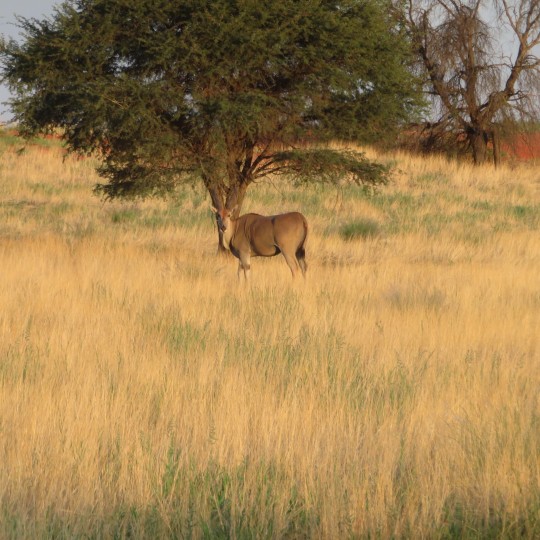
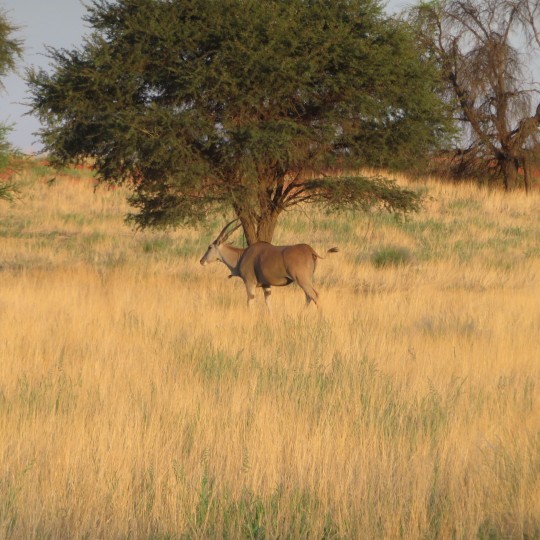
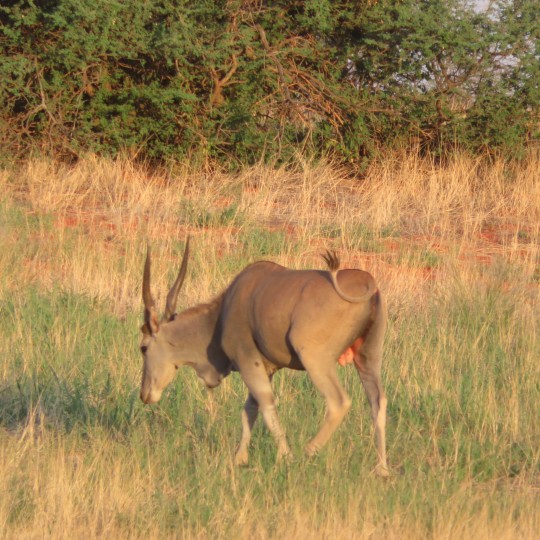
Elenantilopen | Elands
Taurotragus oryx
1 note
·
View note
Photo

Common eland (Taurotragus oryx) cow with calf at the Maasai Mara National Reserve, Kenya
Mike Streicher
110 notes
·
View notes
Photo

East African eland (Taurotragus oryx pattersonianus)
Photo by Bart Wursten
#east african eland#eland antelope#taurotragus oryx pattersonianus#taurotragus oryx#taurotragus#tragelaphini#bovinae#bovidae#pecora#ruminantia#cetruminantia#artiofabula#artiodactyla#euungulata#scrotifera#laurasiatheria#eutheria#mammalia#tetrapoda#vertebrata#chordata
16 notes
·
View notes
Photo
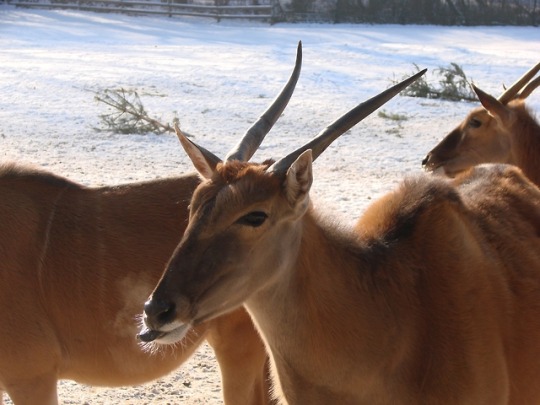
Common Eland (Taurotragus oryx)
1 note
·
View note
Text
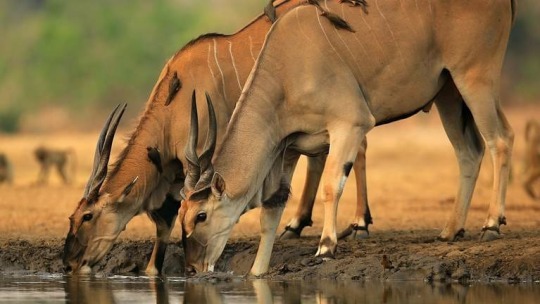


The eland is the largest species of antelope found in the Serengeti. And the largest antelope in Africa. Often found in sizable herds.
Despite their relative abundance, the shyness of elands can make them tricky to approach for good photos, and they are often seen at some distance.
The Serengeti is home to one of the biggest eland populations in Africa and sightings here are frequent. The green season, just after the heaviest of the rains, can be a particularly good time to see them in the southern Serengeti, as they gather in large herds on the short grass plains.
Elands are also commonly seen in Tanzania’s southern parks, either as individuals or in small herds. Use binoculars to spot them on Ruaha’s open plains or look for their movements behind trees and bushes.
The eland is widespread throughout Tanzania – it is estimated there are around 36,000 individuals. They are highly adaptable and can be found across a range of environments and altitudes, even visiting mineral licks on the upper slopes of Kilimanjaro. Their favoured habitat, however, is open grassy plains.
The main subspecies in Tanzania is the East African eland, Taurotragus oryx pattersonianus, characterised by white facial markings and a tan-coloured coat patterned by up to 12 white stripes. Some eland populations in southern Tanzania are the Livingstone’s subspecies (T. o. livingstonii) which has bigger horns and lacks the facial chevrons.
#popular tags#tumblr#tumblrr tmblr tumblrgram tumblrs tumblraesthetic tamblr tumblrfeed tumblrposts tumblr👽 tum#tanzania#adventure#explore#kiwawasafaris#bucketlist#travel
1 note
·
View note
Photo


お母さんの顎置きに使われてる赤ちゃん
@豊橋動植物公園
13 notes
·
View notes
Text

The Eland (Oreas canna) | Joseph Wolf | Zoological sketches v.1 (1861) | Biodiversity Heritage Library | Flickr | Public domain
1 note
·
View note
Photo

Five species of African antelope, that were until recently thought safe, have also been added to the list for the first time. These include the eland (Taurotragus oryx), the biggest antelope in the world, whose status has changed from least concern to vulnerable with an estimated global population of between 12,000 and 14,000. This species is declining due to poaching for bushmeat, encroachment into protected areas and expansion of agriculture and livestock grazing. Political instability and armed conflict in Central African Republic are major barriers to protecting this species.
Photograph: assalve/Getty Images/iStockphoto
32 notes
·
View notes
Photo

“Horns of Taurotragus oryx gigas. The book of antelopes. v.IV. 1899-1900.
126 notes
·
View notes
Photo

Common eland (Taurotragus oryx). . . . . . . . . . . #animal_captures #animals_in_world #splendid_animals #animal_fanatics #animalelite #animal_sultans #world_bestanimal #ir_animals #kings_animals_love #shots_of_animals #ok_animals #wildlife #wildlifephotography #nikon #natgeo #exclusive_wildlife #wildgeography #marvelouz_animals #photowildlife #marvelshots #commoneland #mammals #antelope #cuixmala #mexico #animalkingdom #raw_allanimals (at Cuixmala)
#antelope#marvelshots#marvelouz_animals#photowildlife#animal_sultans#wildlifephotography#ir_animals#ok_animals#cuixmala#mammals#exclusive_wildlife#wildgeography#animal_captures#animal_fanatics#world_bestanimal#splendid_animals#commoneland#shots_of_animals#wildlife#mexico#kings_animals_love#animalelite#animalkingdom#raw_allanimals#animals_in_world#natgeo#nikon
1 note
·
View note


